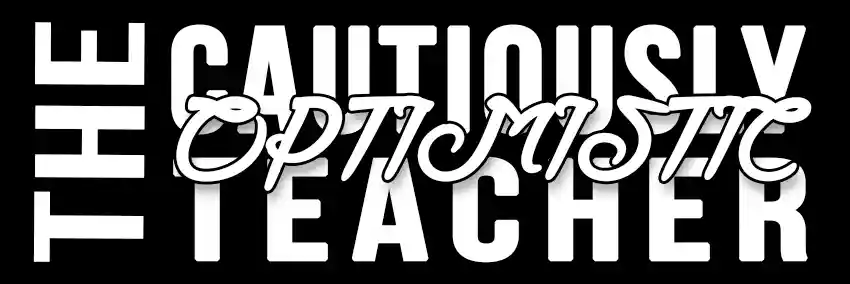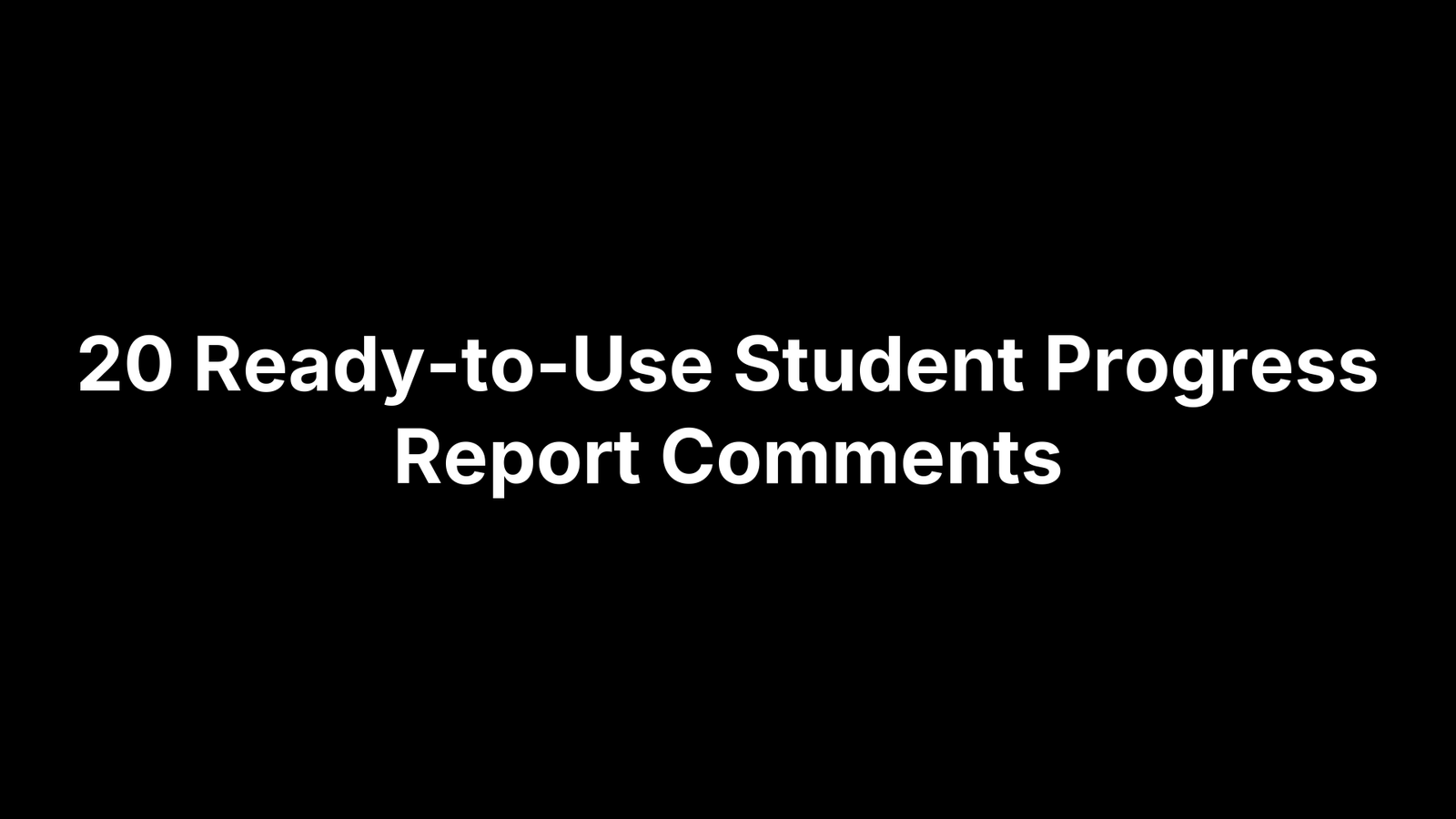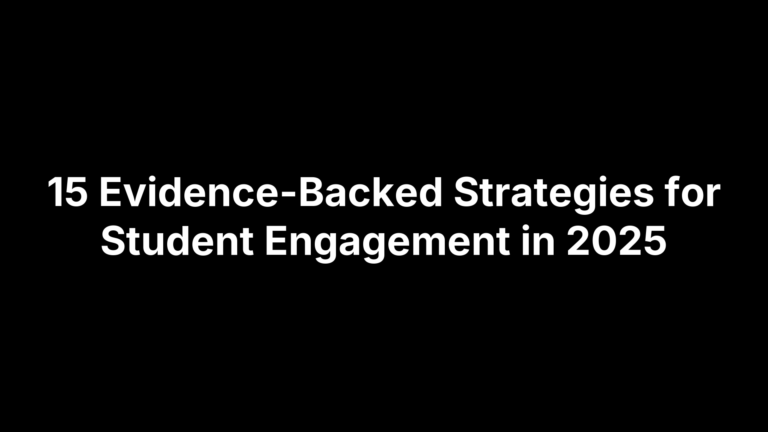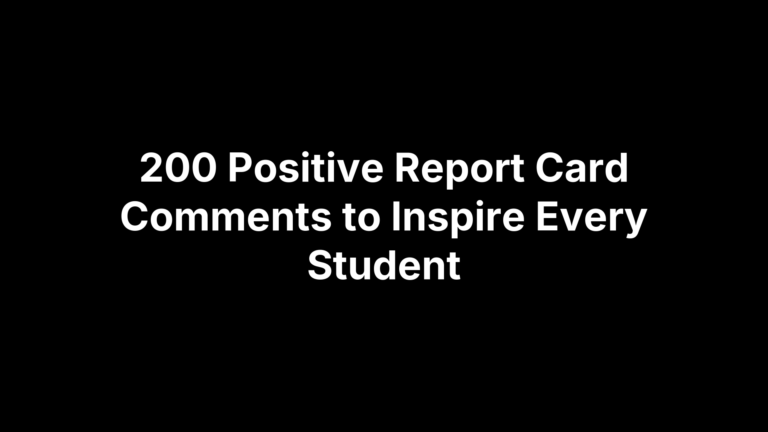20 Student Progress Report Comments You Can Use Today
Report card writing week already devours enough prep time, so we’ve gathered 20 polished progress-report comments you can copy, paste, and tweak in seconds. Whether you need to praise mastery, outline next steps, or encourage a growth mindset, each line is classroom-tested and parent-approved, saving you from staring at a blank grade-book screen.
Thoughtful feedback goes far beyond checking a compliance box; it clarifies learning goals for students, builds trust with families, and documents growth for future instruction. That’s why every comment below comes with two quick extras: a personalization tip that makes the note sound like you wrote it just for that student, and a simple action step caregivers can try at home. Looking for guidance on “How do I comment on a student progress report?” or “What’s a good remark for a report card?” By the end of this list, you’ll have answers—plus time left for an actual lunch break.
1. Demonstrates consistent mastery of new concepts with minimal support
When a learner is able to grab hold of fresh material and run with it almost instantly, families deserve to hear more than “doing great.” A clear comment should spotlight the independence on display, hint at the next level of challenge, and reassure caregivers that their child is ready for stretch goals. Use the template below as your starting point, then sprinkle in the details that make the praise feel genuine.
Ready-Made Comment
“[Student Name] consistently grasps new skills and ideas with little adult guidance, showing a deep understanding of recent material and the confidence to apply it independently.”
Personalization Tips
- Name a just-finished unit or standard: “during our fractions unit” or “in the civil rights inquiry.”
- Point to one assessment or project that showcased mastery.
- Replace “little adult guidance” with an exact phrase like “after one mini-lesson” for extra precision.
Suggested Action Steps for Home
- Offer enrichment: suggest a related podcast episode or library book to extend learning.
- Encourage your child to teach the concept to a sibling or friend—peer explaining cements understanding.
- Try a mini real-world project (e.g., planning a grocery budget to practice those fraction skills).
2. Shows steady improvement through dedicated effort and perseverance
Some gains are gradual but unmistakable. Spotlighting a learner’s upward trend tells families that persistence—not perfection—fuels growth and answers the common “in-progress” question that shows up in many student progress report comments. It also reinforces your classroom culture: consistent effort is noticed and celebrated.
Ready-Made Comment
“[Student Name] has raised their quiz average from ___ % to ___ % this quarter through sustained practice and a willingness to tackle mistakes head-on, demonstrating admirable perseverance and a clear commitment to improvement.”
Personalization Tips
- Pinpoint one concrete strategy the student chose—daily flash-card drills, peer-tutoring sessions, or reworking homework corrections.
- Replace “quiz average” with another metric (reading level, words-per-minute, lab accuracy) that best showcases growth.
- Note the time frame (“over the past six weeks”) for extra clarity.
Suggested Action Steps for Home
- Celebrate the progress together: a simple high-five, note on the fridge, or favorite snack can reinforce effort.
- Help your child set a fresh, bite-sized goal (e.g., boost the next quiz by 3 points).
- Schedule brief weekly check-ins to review progress charts and adjust study strategies if needed.
3. Actively participates in discussions and enriches class dialogue
A lively voice in class can lift everyone’s thinking, so it’s worth capturing that contribution in your student progress report comments. When you recognize not just frequent hand-raising but thoughtful listening and idea-building, you model the kind of academic discourse students will need in higher grades and future workplaces.
Ready-Made Comment
“[Student Name] regularly contributes insightful questions and evidence-based opinions, elevating our classroom conversations and encouraging peers to think more deeply about the topic at hand.”
Personalization Tips
- Mention a recent event—Socratic circle, fishbowl debate, or literature seminar—where the student’s comment shifted the discussion.
- Highlight a specific habit, such as citing page numbers or respectfully challenging assumptions.
- Note any cross-subject transfer (“connected our history lesson to current events in science”).
Suggested Action Steps for Home
- At dinner, invite your child to summarize today’s lesson and ask family members for their perspectives.
- Listen to a short podcast together, pausing to practice follow-up questions.
- Encourage participation in community forums—book clubs, youth council—to keep those dialogue muscles strong.
4. Completes assignments accurately and on time
Families value dependability as much as lofty grades—they want to know their child can manage deadlines and submit work that doesn’t need a second pass. A concise comment here highlights punctuality, precision, and the habits that keep late-night grading piles to a minimum. It also signals that the student is ready for increased responsibility, such as leading a peer‐review group or managing a long-term project schedule.
Ready-Made Comment
“[Student Name] consistently submits both digital and paper assignments on or before the due date and demonstrates careful attention to detail, resulting in accurate, high-quality work that meets or exceeds stated criteria.”
Personalization Tips
- Specify the platform or medium—“uploads Google Classroom tasks” or “turns in lab notebooks.”
- Acknowledge a stand-out piece, like a flawlessly formatted bibliography or error-free problem set.
- Replace “meets or exceeds” with rubric language (“proficient” or “advanced”) to mirror your grading scale.
Suggested Action Steps for Home
- Hold a five-minute Sunday planner check to map upcoming deadlines.
- Use color-coded folders (physical or digital) so each subject’s work is easy to locate.
- Encourage a daily “quick proofread” habit before clicking “turn in” or placing papers in the backpack.
5. Displays strong problem-solving skills and critical thinking
When students can untangle messy situations—whether isolating variables in a chemistry lab or writing efficient code in an elective—they prove they’re ready to tackle higher-order challenges. Your student progress report comments should spotlight how the learner analyzes information, tests ideas, and adapts when a first plan stalls. Doing so reassures families that their child isn’t just memorizing content but actively building the cognitive toolkit needed for college, careers, and life’s curveballs.
Ready-Made Comment
“[Student Name] approaches complex tasks with a systematic mindset, testing multiple strategies during recent science labs and math challenges to arrive at accurate, well-reasoned solutions.”
Personalization Tips
- Reference a specific project: “designing the water-filter prototype” or “solving multistep algebra proofs.”
- Highlight a thinking routine observed—creating decision trees, annotating diagrams, or verbalizing ‘what-if’ scenarios.
- Swap in subject-specific vocabulary, e.g., “hypothesis,” “algorithm,” or “counterclaim,” to mirror class language.
Suggested Action Steps for Home
- Introduce weekly logic puzzles or brainteasers to keep analytical skills sharp.
- Encourage your child to explain their reasoning while planning a family budget or recipe scale-up.
- Explore free STEM maker videos, then try a mini build together, prompting your child to predict, test, and iterate.
6. Applies feedback to improve performance and learning outcomes
Few habits accelerate growth more than acting on feedback. When a learner reads comments, revises promptly, and shows measurable gains, families gain a window into genuine academic resilience. Recognizing this cycle in your student progress report comments reinforces the message that critique is a roadmap, not a roadblock.
Ready-Made Comment
“After reviewing teacher feedback, [Student Name] promptly revises work\u2014for example, improving essay structure and clarity within a single class period\u2014which has led to noticeably higher rubric scores and deeper understanding of course objectives.”
Personalization Tips
- Reference turnaround time: “submitted the revised lab report the next morning.”
- Note the feedback medium\u2014annotated Google Doc, audio note, or rubric conference.
- Mention a quantifiable gain: “raised the argument writing score from 2 to 3.5.”
Suggested Action Steps for Home
- Encourage a short reflection journal where your child paraphrases teacher notes and lists next steps.
- Use a simple checklist: Draft \u2192 Feedback \u2192 Revise \u2192 Self-evaluate, posting it near the study space.
- Celebrate revisions, not just final grades\u2014a quick family shout-out when updated work comes home reinforces the growth mindset.
7. Collaborates effectively with peers during group activities
A student who elevates group work keeps projects humming, resolves bumps calmly, and makes sure every voice is heard. Calling out these interpersonal skills in your student progress report comments shows families you value the “soft” skills employers crave just as much as content knowledge. It also spotlights behaviors classmates can emulate—active listening, fair division of labor, and respectful problem-solving.
Ready-Made Comment
“[Student Name] works seamlessly with classmates, balancing leadership and listening roles. They invite input, negotiate fair task distribution, and help the team reach consensus, resulting in productive, positive group outcomes.”
Personalization Tips
- Name the project: “during the renewable-energy poster session” or “while dissecting owl pellets with lab partners.”
- Highlight a specific moment: “stepped back to let a quieter peer present findings” or “merged two conflicting ideas into one workable solution.”
- Swap “classmates” for the exact group—“literature circle” or “robotics squad”—to add authenticity.
Suggested Action Steps for Home
- Enroll your child in a collaborative extracurricular such as debate club, theater, or community sports.
- At home, assign rotating family roles (timekeeper, note-taker) for planning events to practice shared responsibility.
- Encourage reflection: after any group activity, ask, “What did you contribute, and what did you learn from others?”
8. Exhibits a positive attitude and growth mindset toward challenges
When students tackle tough tasks with curiosity instead of dread, their learning curve spikes—and so does class morale. Recording that optimism in student progress report comments signals to families that character growth is part of the grade. This comment also reminds students that attitude is a skill they can control. Parents often ask how to nurture it.
Ready-Made Comment
“[Student Name] approaches new and challenging material with enthusiasm, viewing mistakes as opportunities to learn and consistently applying the ‘power of yet’ to push past initial setbacks.”
Personalization Tips
- Reference a time the student said, “I don’t get this yet, but I will.”
- Name the specific hurdle overcome—multi-step equations, tricky lab setup, dense text.
- Describe a visible shift: relaxed shoulders, wider smile, renewed attempt.
Suggested Action Steps for Home
- Discuss family challenges as “not yet” problems to model resilience.
- Play cooperative games that require trial-and-error, praising each creative tweak.
- Post encouraging phrases on the study wall—“Mistakes = data,” “Effort grows ability.”
9. Needs additional practice to strengthen foundational skills
Sometimes the data show that a student’s learning tower is wobbling because the bottom bricks aren’t secure yet. Addressing that gap early—before moving to tougher content—prevents future frustration and makes your student progress report comments more actionable for families. The key is to frame the need as a normal part of growth rather than a deficit, while pointing everyone toward concrete resources.
By pairing a supportive tone with laser-focused next steps, you reassure caregivers that you have a plan and you welcome their partnership in reinforcing essential building blocks like decoding, math facts, or keyboarding accuracy.
Ready-Made Comment
“[Student Name] is currently working on solidifying foundational skills in ____ and would benefit from continued, targeted practice to increase accuracy and confidence.”
Personalization Tips
- Specify the exact skill: “multi-digit multiplication,” “phonemic segmentation,” or “subject-verb agreement.”
- Reference recent evidence: “scored 6/20 on last week’s math fact check.”
- Note any progress already observed to keep the tone encouraging.
Suggested Action Steps for Home
- Set a 10-minute daily practice routine using flashcards, timed drills, or a trusted app.
- Play quick, real-world games—skip-count while walking stairs or identify verb tenses during dinner conversation.
- Check in weekly with your child to chart growth and celebrate each small gain.
10. Benefits from using organizational tools to manage tasks
Even high-achievers can watch grades slip when notes vanish or due dates sneak up. A nod to organizational skills tells families that structure—not smarts—is the missing piece and invites them to help. Highlighting planners, checklists, or calendar apps also answers the caregiver question: “How can I help at home without reteaching the lesson?”
Ready-Made Comment
“[Student Name] benefits greatly from using a daily planner and color-coded folders, which help keep assignments visible, prioritized, and submitted on time.”
Personalization Tips
- Cite a recent success: “Since color-coding folders, no papers have gone missing this month.”
- Swap in the actual tool: Google Calendar, Trello, or paper agenda.
- Tie the system to an observed need: “Helps reduce last-minute rush on the science project.”
Suggested Action Steps for Home
- Do a quick nightly backpack-and-email sweep to flag new tasks.
- On Sunday, highlight big due dates on a shared weekly calendar.
- Let your child cross items off with a satisfying pen swipe.
11. Requires targeted support to stay engaged during instruction
Some learners drift when lessons run long. Effective student progress report comments spotlight supports that pull attention back without shame and invite families to extend those same strategies beyond the classroom.
Ready-Made Comment
“[Student Name] stays focused with occasional redirection and brief movement or mindfulness breaks, responding positively to these supports and sustaining attention during guided practice and partner work.”
Personalization Tips
- Identify trigger windows—after long lecture or during silent reading.
- Note the cue that works: gentle tap, proximity, or sticky-note reminder.
- Reference a helpful tool already in use: standing desk, fidget, task checklist.
Suggested Action Steps for Home
- Insert two-minute stretch or breathing breaks during homework; timer keeps them tight.
- Practice five-sense grounding before study sessions.
- Post a visual schedule at home that mirrors class periods.
12. Struggles to complete work independently; consider scaffolding
A student who freezes when the teacher steps away usually isn’t lacking ability—just the structures that break a big task into bite-size moves. Flagging this pattern in your student progress report comments reassures families that you’re already layering in supports and invites them to mirror those same scaffolds at home. The tone should be compassionate and solution-oriented, emphasizing gradual release rather than labeling the learner “dependent.”
Ready-Made Comment
“[Student Name] benefits from step-by-step guidance on multi-part assignments and is learning to apply provided scaffolds—such as graphic organizers and guided notes—to increase independence and task completion.”
Personalization Tips
- Specify the context: “during extended-response math problems” or “while drafting research papers.”
- List current scaffolds: sentence starters, color-coded outlines, example problems.
- Mention small wins: “completed two of five steps solo last week,” keeping motivation high.
Suggested Action Steps for Home
- Break homework into timed chunks (e.g., two 15-minute sprints separated by a stretch break) and check off each chunk together.
- Keep printed reference sheets—formula chart, essay outline—within arm’s reach to reduce “blank page” anxiety.
- Gradually remove prompts: first hide one step, then two, celebrating each successful independent stretch.
13. Shows exemplary behavior and respect toward others
Not every skill shows up on a rubric. When a student routinely greets classmates, follows directions without reminders, and diffuses conflicts before they escalate, they create a climate where everyone can learn. Calling out that quiet leadership in your student progress report comments tells families their child’s character is seen and valued.
Ready-Made Comment
“[Student Name] consistently models respectful language and considerate actions, setting a positive example that elevates our classroom culture and supports a safe, inclusive learning environment for all peers.”
Personalization Tips
- Mention a specific moment of kindness: “shared materials with a new student without being asked.”
- Highlight how the behavior impacts others: “helped a classmate regain focus during group work, allowing the team to finish on time.”
- If applicable, note recognition earned: “earned three ‘citizenship’ shout-outs this quarter.”
Suggested Action Steps for Home
- Encourage participation in community service or peer-mentoring programs to extend empathy skills.
- Discuss daily examples of respectful communication—holding doors, active listening, thanking others.
- Celebrate acts of kindness with a simple note or family “high-five” ritual to reinforce positive habits.
14. Demonstrates emerging confidence when presenting ideas
When a previously reserved student starts projecting their voice and standing a little taller at the front of the room, that growth deserves notice. Celebrating these first steps in public speaking reassures families and motivates the student to keep stretching.
Ready-Made Comment
“[Student Name] is beginning to speak more clearly during presentations, sharing ideas with increased volume and confidence while maintaining eye contact with the audience.”
Personalization Tips
- Reference the latest oral report, slide deck, or class debate that showcased this progress.
- Highlight a specific improvement—fewer filler words, steadier pacing, or reduced reliance on note cards.
- Mention any positive peer or teacher feedback to reinforce the win.
Suggested Action Steps for Home
- Invite your child to give a one-minute “daily recap” at dinner to practice concise speaking.
- Record a short video pitch together, then replay it to discuss clarity and posture.
- Encourage low-stakes speaking opportunities such as club announcements or introducing a family event.
15. Takes initiative to seek help and clarify misunderstandings
Students who raise a hand early or swing by office hours before confusion snowballs are practicing self-advocacy—a life skill as important as any standard. Flagging that habit in your student progress report comments lets families know their child understands when to lean on available supports rather than spinning wheels in frustration.
Ready-Made Comment
“[Student Name] proactively seeks clarification—scheduling quick check-ins and asking targeted questions—which resolves misunderstandings early and results in stronger assessment performance.”
Personalization Tips
- Mention a recent instance—“attended math help desk Tuesday”—to show the initiative in action.
- Specify the channel used: email, private chat, or lunchtime clinic.
- Connect initiative to outcome: “boosted quiz score by eight points.”
Suggested Action Steps for Home
- Have your child jot questions during homework, then bring the top two to class.
- Post office-hour times on the fridge so support feels accessible, not intimidating.
- Model help-seeking at home—google a recipe step together or phone a friend for advice.
16. Consistently applies classroom rules and routines
Smooth, predictable transitions don’t happen by accident—students who line up quietly, log in without prompting, and respect device expectations create space for deeper learning. Highlighting this reliability shows families their child’s self-management is already workplace-ready.
Ready-Made Comment
“[Student Name] reliably follows established classroom procedures, from punctual arrivals to proper technology use, setting a positive tone that keeps our lessons running efficiently and respectfully.”
Personalization Tips
- Point to one routine the student nails every day—morning warm-up, lab cleanup, Chromebook checkout.
- Note how their consistency influences peers (“others quickly mirror the behavior”).
- Swap in your classroom language—“bell ringer,” “Do Now,” “exit ticket”—to make the praise feel authentic.
Suggested Action Steps for Home
- Reinforce an evening checklist (pack supplies, charge device) to support on-time starts.
- Keep a visible weekly calendar so upcoming quizzes and materials are never a surprise.
- Praise punctuality at extracurricular events to connect the habit beyond school.
17. Needs reminders to stay on task during independent work
Some learners shine during discussion yet wander when the room goes quiet. Naming that tendency in your student progress report comments reminds families the issue is focus, not ability, and signals that you’re pairing expectations with practical supports.
Ready-Made Comment
“With occasional verbal cues and a visual timer, [Student Name] can regain focus during independent work but still benefits from brief reminders to remain on task and complete assignments.”
Personalization Tips
- Pinpoint common drift periods, e.g., post-recess or computer activities.
- Specify the prompt that works: desk tap, sticky note, or timer buzz.
- Record a recent win: completed math practice within the first focus block.
Suggested Action Steps for Home
- Break homework into 10-minute focus sprints separated by two-minute stretch breaks.
- Create a phone-free, clutter-free study spot stocked only with current materials.
- Post a simple checklist; let your child tick each item to visualize progress.
18. Exhibits noticeable progress in reading comprehension skills
Scoring higher on benchmarks is great, but what really excites caregivers is hearing exactly how their reader is digging deeper into text. Pointing out specific growth—like using text evidence or summarizing accurately—makes your student progress report comments both credible and motivating.
Ready-Made Comment
“[Student Name] now consistently supports answers with relevant text evidence and has raised their Lexile level by ____ points, indicating strong progress in overall reading comprehension.”
Personalization Tips
- Mention the latest assessment or book: “demonstrated with our class novel ‘Esperanza Rising.’”
- Highlight one improved strategy—annotating margins, predicting outcomes, or asking clarifying questions.
- Note quantitative data if available: “moved from 68% to 85% on last month’s comprehension quiz.”
Suggested Action Steps for Home
- Read a short article together; ask your child to cite two details that back up their opinion.
- Use sticky notes for quick summaries at the end of each chapter to reinforce retention.
- Explore a library series slightly above current level to keep challenge and confidence in balance.
19. Shows creativity and originality in project work
Innovative thinking deserves its own spotlight in student progress report comments because it signals that a learner is moving beyond rote completion to authentic expression and risk-taking—skills prized in every subject area.
Ready-Made Comment
“[Student Name] brings fresh perspectives and imaginative flair to project work, transforming guidelines into unique, high-quality products that capture audience interest and exceed expectations.”
Personalization Tips
- Reference a standout artifact: “the stop-motion video explaining plate tectonics” or “the mixed-media poetry collage.”
- Quote a line from the student’s reflection or peer feedback to showcase voice.
- Note how originality advanced learning goals, e.g., “used coding to model data trends, deepening class understanding.”
Suggested Action Steps for Home
- Provide open-ended materials—scrap paper, recyclables, simple coding apps—and invite your child to “build anything useful.”
- Visit a local makerspace, museum, or virtual art gallery together and discuss design choices observed.
- Encourage a weekly creative journal where ideas, sketches, or prototype photos can be stored for future projects.
20. Displays resilience by overcoming setbacks
Setbacks happen—whether a failed hypothesis, a missed free throw in PE, or a low mark on a persuasive essay. What matters is how quickly a student recalibrates, tries again, and grows. Documenting that bounce-back quality in student progress report comments signals to families their child’s grit is translating into observable gains and healthier self-talk.
Ready-Made Comment
“Despite initial challenges, [Student Name] persists through multiple attempts—revising strategies and seeking feedback—until tasks are completed successfully, demonstrating commendable resilience and an ability to turn setbacks into springboards for learning.”
Personalization Tips
- Reference a concrete rebound: “rewrote the lab report after inconclusive data” or “practiced free-response questions to raise the retake score.”
- Highlight language the student used (“I’ll try a new angle”) to show mindset shift.
- If relevant, note the time frame from disappointment to improvement.
Suggested Action Steps for Home
- Share personal “failure stories” at home and discuss lessons learned to normalize risk-taking.
- Set a family goal chart that rewards effort milestones, not just end results.
- Encourage reflection: have your child jot what worked, what didn’t, and the next step after any challenging assignment.
Keep Your Feedback Focused on Growth
Effective student progress report comments share three traits: precision, balance, and a clear runway for action. Pinpoint the evidence—scores, anecdotes, or observable behaviors—so families see exactly what sparked your praise or concern. Pair every commendation with a next step (“try summarizing each chapter aloud”) to keep momentum rolling, and make sure suggested strategies are doable at the kitchen table, not just the classroom.
Remember, feedback is most powerful when it highlights progress already made while nudging students toward the next attainable goal. A quick check before you hit “submit” can help:
- Is the language specific enough for the reader to visualize the behavior?
- Does it affirm effort as well as achievement?
- Will caregivers know how to support the recommendation at home?
Need more tailored phrasing? Test-drive The Cautiously Optimistic Teacher’s free Report Card Commentor to generate individualized feedback in seconds.







